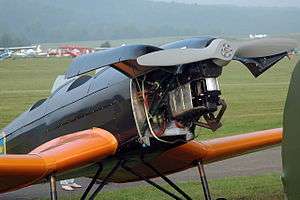Hitachi Hatsukaze
| Hatsukaze | |
|---|---|
 | |
| The Hitachi Hatsukaze was a license-built Hirth HM 504, shown here installed in a Klemm Kl 35 | |
| Type | Four-cylinder liquid-cooled inverted Inline piston engine |
| National origin | Japan |
| Manufacturer | Hitachi |
| Major applications | Kyushu K9W Kokusai Ki-86 |
| Number built | 1,376 |
| Developed from | Hirth HM 504 |
| Variants | Ishikawajima Tsu-11 |
The Hitachi Hatsukaze also known as the Hitachi model GK4, was Hitachi's fourth design in a series of aircraft engines built in Japan prior to and during World War II. The original Hatsukaze was a license-built Hirth HM 504. Hatsukazi engines were air-cooled, four-cylinder, inverted inline engines developing around 82 kW (110 hp).[1]
Design and development
Hatsukaze engines were produced in very large numbers, as the powerplant for the license-built Bücker Bü 131 Jungmann variants that were the standard primary trainers for the Imperial Japanese Navy and Imperial Japanese Army.
The naval version of the engine was designated GK4, the army version as Ha-47.
The Hatsukaze Model 12 was the power section linked to a compressor to create a primitive jet engine called a motorjet; the resulting Tsu-11 was intended to power Yokosuka MXY7 Ohka Model 22 flying bombs. The standard Hatsukaze 11 engine was modified at a Navy arsenal by replacing the propeller drive shaft and engine front crankcase cover with a step-up gearbox. The gearbox increased engine output shaft RPM at a 1:3 ratio. At engine speed of 3,000 RPM, the compressor section was operating at 9,000 RPM. The compressed air was then ducted into a combustion chamber where a liquid fuel was sprayed. The heated compressed air then exits through the tailpipe providing static thrust of 180 kg (396 lb). It is likely that about 1/3 of the total thrust was contributed by adding the combustion chamber aft of the compressor.
The Tsu-11 was also selected to power the Yokosuka MXY-9 Shuka ("Autumn Fire"), a trainer intended to prepare pilots for the Mitsubishi J8M rocket-powered interceptor. Neither of these aircraft entered service, however, as their development took place too late in the war.
Variants
- GK4 Hatsukaze
- license-built Hirth HM 504 inverted inline four-cylinder aviation engine.
- GK4A Hatsukaze 11
- 82 kW (110 hp) IJN version, 339 built [2]
- GK4A Ha-47 11
- 82 kW (110 hp) IJA version, 1,037 built[2]
- Hatsukaze Toku ("Toku" translates as "special") Model 13
- power section for the Ishikawajima Tsu 11 Motorjet engine
Applications
- Kyushu K9W1 Type 2 Momiji ("Cypress") license built Bücker Bü 131s.
- Kokusai Ki-86 Type 4 ("Cypress") license built Bücker Bü 131s.
Specifications (Hatsukaze GK4A)
General characteristics
- Type: 4-cylinder air-cooled inline piston engine
- Bore: 110 mm (4.13 in)
- Stroke: 125 mm (4.53 in)
- Displacement: 4,752 cm3 (290 in3)
- Length: 1,070 mm
- Width: 200 mm
- Dry weight: 115 kg
Components
- Cooling system: Air-cooled
Performance
- Power output: 82 kW (110 hp)
- Compression ratio: 5.8:1
See also
Related development
Related lists
References
Notes
Bibliography
- Bridgeman, Leonard. "The Bücker Bü 131B 'Jungmann'." Jane's Fighting Aircraft of World War II. London: Studio, 1946. ISBN 1-85170-493-0.
- Jackson, Paul. Jane's All The World's Aircraft 2003–2004. Coulsdon, UK: Jane's Information Group, 2003. ISBN 0-7106-2537-5
- Francillon, R.J. Japanese Aircraft of the Pacific War. London, Putnam, 1970. ISBN 0-370-00033-1.